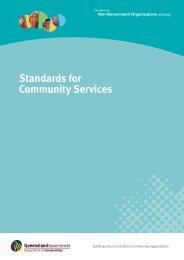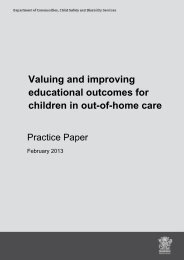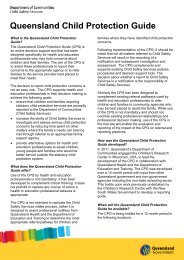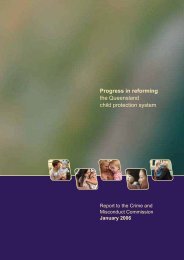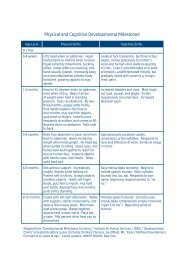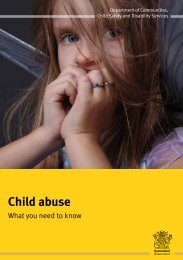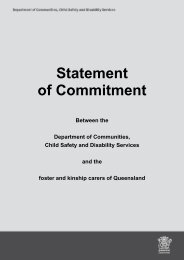Housing and Support Program (HASP): Final Evaluation Report
Housing and Support Program (HASP): Final Evaluation Report
Housing and Support Program (HASP): Final Evaluation Report
You also want an ePaper? Increase the reach of your titles
YUMPU automatically turns print PDFs into web optimized ePapers that Google loves.
etter functioning). However, while these changes/<br />
improvements approached signifi cance, they were<br />
not statistically signifi cant.<br />
6.3 Clients who improved, stayed the<br />
same, or deteriorated<br />
While some of the clients improved, others remained<br />
the same or deteriorated. Identifying the proportion<br />
of clients in each of these groups is a useful method<br />
of assessing outcomes. To identify those in the three<br />
categories (improved, remain the same, deteriorated)<br />
we added the two-scale scores pre-<strong>HASP</strong> (i.e. the<br />
score for HoNOS at 12 months pre <strong>and</strong> three months<br />
pre) <strong>and</strong> subtracted the combined score from the two<br />
measures post-<strong>HASP</strong>. This provided a range of ‘change’<br />
scores. We then calculated the st<strong>and</strong>ard deviation for<br />
the change scores. One st<strong>and</strong>ard deviation around the<br />
mean was used to differentiate between clients in each<br />
of the groups. Thus, clients with a total scale score<br />
greater than .5 of a st<strong>and</strong>ard deviation above the mean<br />
were classifi ed as having highly deteriorated (since<br />
a higher score represented more severe problems).<br />
Those with scores less than .5 of a st<strong>and</strong>ard deviation<br />
below the mean were classifi ed as having improved,<br />
while those with scores ± .5 of a st<strong>and</strong>ard deviation<br />
around the mean were classifi ed as having remained<br />
the same. The data for each category is summarised<br />
in the Table below.<br />
Table 6.1 Proportion of clients who improved,<br />
stayed the same, or deteriorated<br />
Group Proportion<br />
of clients who<br />
improved, stayed<br />
the same or<br />
deteriorated<br />
Life Skills Profile<br />
(LSP Data)<br />
Proportion<br />
of clients who<br />
improved, stayed<br />
the same or<br />
deteriorated<br />
Health of the<br />
Nation Outcomes<br />
(HoNOS Data)<br />
Improved 51.0% 42.9%<br />
Stable 19.6% 33.3%<br />
Deteriorated 29.4% 23.8%<br />
It is clear from the data that just over half of the clients<br />
in the study group improved on measures of their life<br />
skills performance, while 43% showed improvement<br />
on clinical functioning.<br />
6.4 Perceptions of change in client<br />
functioning — Case Managers versus<br />
support workers<br />
Case Managers (n=40) <strong>and</strong> support workers (n=58)<br />
were asked to indicate their level of agreement with<br />
the statement ‘the functioning of <strong>HASP</strong> clients has<br />
improved in the past six months’. The responses<br />
for both groups are compared in the graph below.<br />
Fig. 6.2 Change in client functioning —<br />
past six months versus next six months<br />
Percent<br />
100<br />
80<br />
60<br />
40<br />
20<br />
0<br />
Legend<br />
Strongly<br />
agree<br />
Agree<br />
Case<br />
Managers<br />
Neither<br />
<strong>Support</strong><br />
workers<br />
Disagree<br />
Strongly<br />
disagree<br />
Sixty-two percent (62%) of Case Managers agreed that<br />
the functioning of <strong>HASP</strong> clients had improved over the<br />
past six months. This is compared with 69% of support<br />
workers who believed that the functioning of <strong>HASP</strong><br />
clients had improved over the past six months.<br />
<strong>Housing</strong> <strong>and</strong> <strong>Support</strong> <strong>Program</strong> (<strong>HASP</strong>)<br />
57



